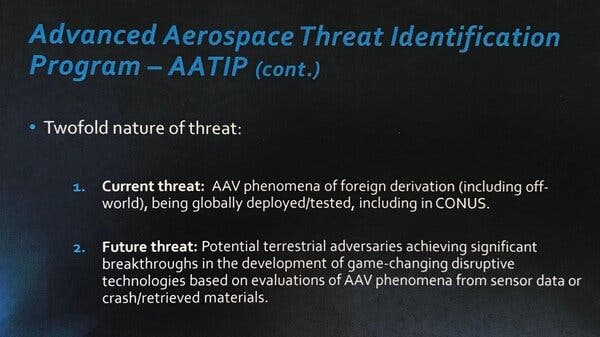Do We Believe in U.F.O.s? That’s the Wrong Question
Times Insider explains who we are and what we do, and delivers behind-the-scenes insights into how our journalism comes together.
We were part of The New York Times’s team (with the Washington correspondent Helene Cooper) that broke the story of the Pentagon’s long-secret unit investigating unidentified flying objects, the Advanced Aerospace Threat Identification Program, in December 2017.
Since then, we have reported on Navy pilots’ close encounters with U.F.O.s, and last week, on the current revamped program, the Unidentified Aerial Phenomenon Task Force and its official briefings — ongoing for more than a decade — for intelligence officials, aerospace executives and Congressional staff on reported U.F.O. crashes and retrieved materials.
We’re often asked by well-meaning associates and readers, “Do you believe in U.F.O.s?” The question sets us aback as being inappropriately personal. Times reporters are particularly averse to revealing opinions that could imply possible reporting bias.
But in this case we have no problem responding, “No, we don’t believe in U.F.O.s.”
As we see it, their existence, or nonexistence, is not a matter of belief.
We admire what the great anthropologist Margaret Mead said when asked long ago whether she believed in U.F.O.s. She called it “a silly question,” writing in Redbook in 1974:
“Belief has to do with matters of faith; it has nothing to do with the kind of knowledge that is based on scientific inquiry. … Do people believe in the sun or the moon, or the changing seasons, or the chairs they’re sitting on? When we want to understand something strange, something previously unknown to anyone, we have to begin with an entirely different set of questions. What is it? How does it work?”
That’s what the Pentagon U.F.O. program has been focusing on, making it eminently newsworthy. And to be clear: U.F.O.s don’t mean aliens. Unidentified means we don’t know what they are, only that they demonstrate capabilities that do not appear to be possible through currently available technology.
In our reporting, we’ve focused on how the Department of Defense, the Office of Naval Intelligence and members of two Senate committees are engaged with this topic. Current officials are now concerned about the potential threat represented by the very real, advanced technological objects: how close they can come to our fighter jets, sometimes causing a near miss, and the risk that our adversaries may acquire the technology demonstrated by the objects before we do.
So if U.F.O.s are no longer a matter of belief, what are they and how do they do what they do?
And if technology has been retrieved from downed objects, what better way to try to understand how they work?
Our previous stories were relatively easy to document with Department of Defense videos of U.F.O.s and pilot eyewitness accounts backed up by Navy hazard reports of close encounters with small speeding objects.
But our latest article provided a more daunting set of challenges, since we dealt with the possible existence of retrieved materials from U.F.O.s. Going from data on a distant object in the sky to the possession of a retrieved one on the ground makes a leap that many find hard to accept and that clearly demands extraordinary evidence.
Numerous associates of the Pentagon program, with high security clearances and decades of involvement with official U.F.O. investigations, told us they were convinced such crashes have occurred, based on their access to classified information. But the retrieved materials themselves, and any data about them, are completely off-limits to anyone without clearances and a need to know.

We were provided a series of unclassified slides showing that the program took this seriously enough to include it in numerous briefings. One slide says one of the program’s tasks was to “arrange for access to data/reports/materials from crash retrievals of A.A.V.’s,” or advanced aerospace vehicles.
Our sources told us that “A.A.V.” does not refer to vehicles made in any country — not Russian or Chinese — but is used to mean technology in the realm of the truly unexplained. They also assure us that their briefings are based on facts, not belief.
Ralph Blumenthal was a Times reporter from 1964 to 2009. Leslie Kean has written a book and articles on U.F.O.s.
*** This article has been archived for your research. The original version from The New York Times can be found here ***


